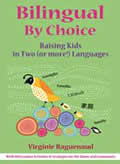 Title: Bilingual By Choice: Raising Kids in Two (or More!) Languages
Title: Bilingual By Choice: Raising Kids in Two (or More!) Languages
Author: Virginie Raguenaud
Source: Veddma library
ISBN: 978-1857885262
Available online
Notes: The first eight chapters (out of ten) of this book are devoted primarily to the discussion of why it is beneficial to be bilingual, why it is important to retain your heritage language and teach it to your children, and why being bilingual is not unpatriotic. The author’s target audience is clearly the American readers, and she repeatedly uses Barack Obama’s family as an example of why being bilingual does not imply you are a poor Latino immigrant. It is quite baffling to read about the social and political obstacles people face in the US, since in most European countries and in Canada knowing more than one language is a norm, and is widely recognized as an asset in many areas of life.
If you know that you do want to raise your children bilingual, the only really useful information is contained in the last two chapters of this book. Here is where the author actually suggests some activities you can do to expose your children to the chosen language and culture. Some of these activities are US-specific, some are only available in the most widespread languages such as French and Spanish, and yet others are simply things to do with children to which you can (after some research) provide a running commentary in the target language.
The author also keeps switching the assumption for her statements from being applicable to an immigrant family in which all members have to learn a new language, to an assumption that each parent speaks their own language. The problems arise when among suggestions of what to do with children the assumption is made that the language being taught to them is known to every family member. However, if a family member does not speak that language, things like having family game nights become a not-a-whole-family affair, thus limiting the possibilities of language-related activities to engage in as a family even further.
Some of the interesting suggestions are:
- using the target language to narrate your activities, such as laundry sorting, car repair, gardening, cooking, child’s hobbies etc.;
- singing;
- reading;
- stargazing with narration;
- postcard exchange and Skype sessions with far-away family members that speak the language;
- bringing the language into the environment: decorating the room with words, putting stickers on household objects with their names, getting placemats with words, putting a saying in the target language on your child’s t-shirt (letting them select the saying), doing sidewalk art;
- bilingual babysitters, hosting an international student, reading bilingual newspapers, participating in essay contests, and family poetry nights;
- entertainment in the target language, including Sesame Street Around the World, films, videos, songs on the child’s iPod, children’s books;
- acquiring bilingual dolls, or a pet that you claim to the child can only speak the target language;
- online activities, such as Internet radio, videos, news, free online courses;
- activities in the community, such as tours of museums, fire stations, hospitals, the zoo, aquarium, farms, construction sites, recycling centre, etc. with a narration by a language speaker;
- free movies at the university in your target language;
- summer language camp, boy/girl scouts;
- trips to the country of the language origin.
The book can benefit from proofreading: there are a few places where the sentences do not make sense due to mixed grammatical tenses. Even on the cover there is a syntax error: I am assuming that the word spelled as “семъя” is meant to be “family” in Russian, which is correctly spelled “семья”. A slight difference that might not be noticeable to a person unfamiliar with the language, but shouldn’t that warrant a proofreading by someone who is?
Overall, I found the book quite repetitive on all the benefits of bilingualism and lacking in practical information on how to actually proceed raising children in more than one language.





